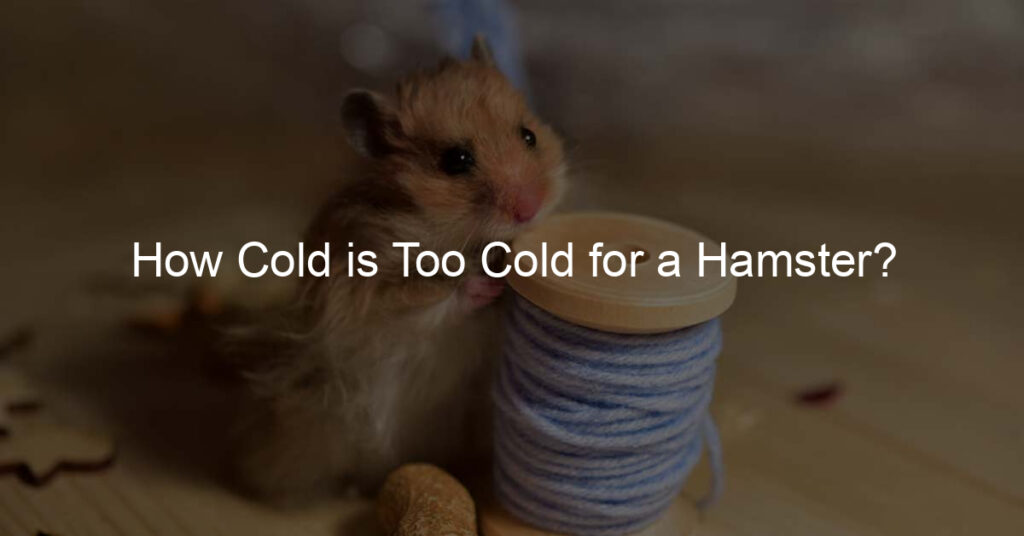Hamsters are popular pets known for their adorable appearance and lively behavior. Providing a comfortable environment is essential for the well-being of these furry little creatures.
One of the critical factors influencing their comfort and health is maintaining the appropriate temperature in their living space.
Understanding how cold is too cold for a hamster is an important aspect of being a responsible pet owner.
Hamsters thrive in temperatures between 65°F and 75°F (~18.5°C – 24°C) with no drafts or direct sunlight. Temperatures below 60°F (15°C) may cause your hamster to enter a state called torpor, similar to hibernation.
Prolonged cold can lead to dehydration and hypothermia, while high temperatures may cause heatstroke and may be fatal.
Key Takeaways
- Hamsters’ ideal temperature range is between 65°F and 75°F (18.5°C – 24°C)
- Exposure to temperatures below 60°F (15°C) can cause hamsters to enter torpor, potentially leading to health issues
- Maintaining proper ventilation and a balanced diet can play a role in keeping your hamster comfortable in cold conditions
Understanding Hamster’s Ideal Temperature
As a hamster owner, it’s important to ensure that your furry friend is comfortable and safe in their environment. One critical aspect of this is maintaining the ideal temperature for their well-being.
In general, hamsters thrive in temperatures between 65 degrees and 80 degrees Fahrenheit (20-22 degrees Celsius).
Hamsters are sensitive creatures, so adjusting the temperature within this range is key to keeping them healthy and preventing issues such as hibernation. When the temperature drops below 15 Celsius (60 Fahrenheit), your hamster may enter a state of hibernation, which can be dangerous to their health.
Hibernation leads to dehydration and malnourishment, so it’s best to avoid this situation.
Factors like age, sex, and environment can affect a hamster’s body temperature. On average, a hamster’s body temperature ranges from 97°F to 100°F (36.1°C to 37.8°C). Younger hamsters usually maintain a higher body temperature than older ones.
To create a comfortable environment for your hamster, try to keep the room temperature within the optimal range of 68-72 degrees Fahrenheit (20-22 degrees Celsius). This temperature ensures that they stay warm enough to avoid hibernation and cool enough to prevent heatstroke.
Regularly monitoring the temperature and making necessary adjustments will ensure your hamster stays comfortable and healthy. You can use a thermometer specially designed for pet habitats to easily check the temperature in your hamster’s living space.
Remember, a happy hamster is one that is well cared for and lives in a safe, comfortable environment.
Temperature Range
Hamsters are small, sensitive pets that require a comfortable environment to thrive. One crucial aspect of their habitat is temperature. The ideal temperature range for a hamster is between 20-23 degrees Celsius (68-75 degrees Fahrenheit).
This temperature ensures a happy and healthy hamster.
It is vital to maintain this temperature range, especially during the winter months when the surrounding environment becomes cooler. If a hamster’s environment falls significantly below 20 degrees Celsius (68 degrees Fahrenheit) for a prolonged period, the hamster may become cold.
This can lead to complications, such as torpor – a temporary hibernation state that can be dangerous and fatal for hamsters.
To help your hamster stay warm and comfortable during colder months, consider the following tips:
- Keep your hamster’s cage away from drafty windows or doors.
- Place additional bedding in the cage to help insulate and provide warmth.
- Use a small animal heat mat or safe heating pad under a portion of the cage to provide a warm area for your hamster.
Remember, it is essential to monitor the temperature within your hamster’s environment regularly and make adjustments as needed to ensure their well-being. By maintaining a suitable temperature range, you can help your hamster stay happy, healthy, and comfortable all year round.
Syrian Hamster Specifications
Syrian hamsters are popular pets, and it’s essential to understand the appropriate temperature range for their well-being. These little creatures are most comfortable in temperatures between 65 and 80 degrees Fahrenheit, with humidity levels of 40 to 70 percent.
When the room temperature falls below 65 degrees Fahrenheit, a Syrian hamster may begin to feel cold. If exposed to temperatures of 60 degrees Fahrenheit or lower for an extended period, the hamster can become ill.
It is crucial not to let the room temperature drop below 20 degrees Celsius (68 degrees Fahrenheit) for a long period, as this can be detrimental to the hamster’s health.
To help maintain a comfortable environment for Syrian hamsters, consider taking the following steps:
- Monitor room temperature: Keep an eye on the temperature in the room where the hamster lives. Use a thermostat to ensure consistency in maintaining the ideal range.
- Proper bedding: Ensure that the hamster’s cage has cozy bedding to help them stay warm. Using materials like paper, hay, or even shredded tissues will create a soft, insulating layer.
- Nesting box: Provide a nesting box or hiding place where the hamster can retreat when they feel cold. This can be something as simple as a cardboard box or a small plastic hideaway.
Keep in mind that every hamster is different, and individual preferences for temperature may vary. Being observant of your pet’s behavior and making adjustments to their environment accordingly will help keep them safe and healthy.
Effects of Cold on Hamsters
Hamsters are sensitive creatures that require a stable and warm environment to thrive. When exposed to cold temperatures, they can experience various health issues, some of which can even become life-threatening.
A hamster’s metabolic rate slows down when it experiences cold temperatures, which can make the animal lethargic and less active. This decrease in activity conserves energy and also results in a reduced appetite and potential weight loss.
It’s important to monitor your hamster’s eating habits in cold conditions, as a lack of proper nutrition can lead to further health problems.
Another concern for hamsters in cold environments is the risk of entering hibernation. While hamsters do hibernate in the wild, it can be dangerous for them in captivity, especially if it’s unexpected or they are not well prepared.
Hibernation causes a hamster’s heart rate and body temperature to drop significantly, which can lead to severe health complications or even death.
Exposure to cold air can also put hamsters at risk for hypothermia, which occurs when their body temperature falls below the normal range. Symptoms of hypothermia include shivering, lethargy, and a low body temperature.
If left untreated, hypothermia can lead to hypothermic shock and become life-threatening.
Respiratory issues are another concern for hamsters exposed to cold air. They can develop a runny nose and be at a higher risk for developing pneumonia, which is a severe inflammation of the lungs caused by bacteria, viruses, or other pathogens.
Pneumonia in hamsters can be fatal if not treated promptly and properly.
Dehydration is also a risk for hamsters in cold environments. Lower temperatures can lead to decreased water consumption, making it essential to monitor their hydration and ensure they have access to fresh water at all times.
In conclusion, it is crucial to take proper precautions and provide a suitable environment for hamsters during colder months.
Providing ample bedding, warm locations, and possibly heat pads or lamps can help maintain a comfortable temperature for your furry friends and prevent the various health issues associated with cold conditions.
Hamster’s Behavior under Cold
Hamsters, being small mammals, are quite sensitive to temperature changes. When the temperature drops too low, they may exhibit certain behaviors to cope with the cold.
In this section, we’ll discuss how hamsters might react in cold environments and some ways they try to stay warm.
Firstly, hamsters will often seek out a cozy and warm place to rest. They do this by burrowing in their bedding or creating a nest using available materials. In the wild, hamsters are known to dig elaborate burrows to escape the cold and maintain a stable living environment.
Likewise, a pet hamster may retreat to a designated sleeping area in their cage filled with soft, warm nesting material like shredded paper or aspen shavings.
To stay warm in cold temperatures, hamsters may also huddle with their siblings or other cage mates. By curling up together, they can effectively retain body heat and create a warm micro-environment for themselves.
This behavior is especially crucial for dwarf hamsters, which are more prone to losing body heat.
Additionally, during cold periods, a hamster’s activity level may decrease. They might become less active or spend more time sleeping in their burrows. This slowing down can be a response to conserve energy when faced with increasing cold.
It’s important to monitor your hamster’s activity level and ensure they maintain a healthy balance between rest and play.
When taking care of a hamster in a colder environment, it’s crucial to provide proper insulation and plenty of nesting material and monitor the ambient temperature (ideally between 68-75 degrees Fahrenheit) to keep your furry friend comfortable and healthy.
Protecting Hamster from Cold
Hamsters are sensitive to temperature changes and can get cold if the room temperature falls below 20°C (68°F) for an extended period. To ensure a comfortable living environment for your hamster, it is crucial to maintain a temperature range of 20-23°C (68-75°F).
Here are some friendly tips on how to protect your hamster from the cold.
To begin with, monitor the temperature of your hamster’s enclosure using a thermometer. By keeping track of the temperature, you can take timely action to regulate it as needed.
Insulation plays a vital role in maintaining an appropriate temperature within the hamster’s habitat. Placing the enclosure against an interior wall can help minimize drafts, which could reduce the temperature inside.
Additionally, you can use thick fabric or insulation material to provide an extra layer of protection against cold air.
Provide plenty of clean and dry bedding. Supplies like aspen shavings, paper-based bedding, or even shredded tissue can be helpful. These materials allow hamsters to create cozy nests for themselves by burrowing and adding insulation from drafts.
Consider using a heating pad if needed. Place the heating pad under a section of the enclosure to create a warm spot. Ensure the heat provided by the pad is not too intense, and the hamster has room to move away if it gets uncomfortable.
Keep a close watch on your hamster’s behavior to ensure their comfort and safety.
Protecting your hamster from the cold involves maintaining a consistent temperature within their enclosure, insulating their living space, and providing ample bedding for them to burrow and nest.
Following these friendly tips can keep your little furry friend warm, happy, and healthy during colder months.
Environment
Hamsters are sensitive to temperature changes, and providing them with an appropriate environment is crucial for their well-being.
In particular, it is essential to make sure that the room temperature for your hamster does not fall below 18 degrees Celsius (64 degrees Fahrenheit) for dwarf hamsters and below 8°C (46°F) for Syrian hamsters.
Any lower temperatures can cause your hamster to go into a state called torpor, which may be dangerous and potentially fatal.
Selecting the Right Bedding
One of the factors that can contribute to maintaining an ideal temperature for your hamster is choosing the right type of bedding. Selecting appropriate bedding material is essential to ensure that your furry friend stays warm, snug, and happy.
Here are several types of bedding to consider:
- Fleece: Fleece bedding is soft, warm, and cozy for your hamster. It’s an excellent option for keeping your hamster insulated from the cold. Fleece is also easy to clean and replace.
- Shredded paper: Shredded paper bedding is another good option that can keep your hamster warm. It is affordable, widely available, and has excellent insulating properties. However, if you choose this option, make sure the paper is ink-free and unscented to prevent health issues for your hamster.
- Wood shavings: Some wood shavings, such as aspen, can be used for hamster bedding. They offer impressive insulation and absorbency. However, it’s essential to avoid cedar and pine shavings, as they may cause respiratory problems for your hamster.
Keep in mind that the most important aspect of selecting the right bedding is providing warmth and insulation to protect your hamster from the cold.
For comfort, it’s suggested to combine some of the bedding options mentioned to create a snug and cozy environment that will keep your hamster safe and warm.
How Cold is Too Cold for a Hamster
Hamsters thrive in temperatures between 65 – 75°F (~18.5 – 24°C). If temperatures fall below 60°F (15°C), they may enter a state called torpor, similar to hibernation, which can lead to dehydration or hypothermia.
On the other hand, high temperatures can cause heatstroke, which may be fatal.
Creating a Warm Environment
To ensure your hamster stays comfortable, it is essential to create a warm environment. There are several methods you can use to maintain the appropriate temperature in your hamster’s living space.
- Heating: There are various heating options, such as heating pads, heat lamps, or even space heaters, that can help regulate the temperature. Make sure to use heaters designed for small animals and follow safety instructions closely to avoid burns or fires.
- Nesting materials: Providing soft, warm nesting materials like paper bedding, clean cloth scraps, or tissues allows your hamster to build a cozy nest for added insulation and warmth.
- Insulation: To further insulate your hamster’s habitat, you can place a blanket or towel around the cage, but make sure to leave some areas open for ventilation.
- Warmth: Regularly check the temperature in the room and adjust the heating equipment accordingly to ensure your hamster stays comfortable and healthy.
Remember that a comfortable environment is essential for your hamster’s well-being. Keep these points in mind to create a space your little friend will love and feel safe in.
Importance of Proper Ventilation
Hamsters, like all living creatures, need proper ventilation in their environment to ensure their well-being.
Good airflow in a hamster’s cage not only maintains a comfortable temperature but also helps to keep the air fresh by dissipating ammonia and other odors produced by your pet’s waste.
In addition, adequate ventilation can prevent the growth of harmful bacteria and fungi, making the cage a safer and more hygienic space for your little friend.
When selecting a hamster cage, opt for one with proper ventilation, such as those with wire or mesh sides. This design allows air to circulate freely, keeping the habitat at a comfortable temperature and minimizing the buildup of unhealthy air.
Avoid using an aquarium or a cage with solid walls, as these tend to restrict airflow and may result in a stuffy environment for your pet.
It’s equally crucial to place the cage in a location that avoids drafts and cold air, which can lead to a chilly habitat and health issues for your hamster. Ensure that the area is not near any windows or doors that might introduce drafts.
Moreover, refrain from placing the cage in an attic, garage, or basement, as these spaces may have significant temperature fluctuations depending on the season.
Lastly, it’s a good practice to regularly clean your hamster’s cage and replace bedding materials. This helps to keep the air fresh and reduces the risk of ammonia buildup.
Implementing a consistent cleaning routine and providing proper ventilation will contribute to a cozy and healthy environment for your hamster.
Remember that the ideal temperature range for hamsters lies between 65 – 75°F (18.5 – 24°C), with 68 – 72°F (20-22°C) being optimal. Maintaining a well-ventilated cage within these temperature ranges will go a long way in supporting your hamster’s overall health and happiness.
Risks of Overheating
It’s crucial for hamster owners to be aware of the risks associated with overheating. Hamsters are sensitive to high temperatures and can suffer from heatstroke if their environment becomes too hot.
Keep an eye on the temperature in your hamster’s living space and aim for it to remain within a temperature-controlled range of 18-24°C (64-75°F).
Direct sunlight can be particularly dangerous for hamsters, as it can significantly raise their body temperature and increase the risk of heatstroke.
Avoid placing your hamster’s cage near windows or other sources of direct sunlight, and consider drawing the blinds or curtains during particularly hot or sunny days to reduce the temperature in your hamster’s environment.
Dehydration is another concern when it comes to overheating. Hamsters require a constant supply of fresh water to stay properly hydrated. Ensure that your hamster’s water bottle is always full and clean, and monitor them for signs of dehydration, such as lethargy, sunken eyes, and dry, pale gums.
If you notice any of these symptoms, it’s essential to take action immediately to help your hamster recover.
Heatstroke is a serious condition and can be life-threatening for your hamster. Signs of heatstroke include heavy panting, rapid breathing, lethargy, and unresponsiveness.
If you suspect your hamster is experiencing heatstroke, take the following steps:
- Move your hamster to a cooler location, ideally within the ideal temperature range.
- Provide fresh water for them to drink, and use a dropper if they are unable to drink on their own.
- Dampen a cloth with cool (not cold) water and gently apply it to your hamster’s body. Be careful not to cover their face and avoid soaking their fur.
By being aware of the risks of overheating and taking appropriate action to keep your hamster cool and hydrated, you can minimize the chances of heat-related health issues.
Role of Nutrition in Cold
Hamsters are small creatures with high metabolisms, making it essential to feed them the right food to help them maintain proper energy levels, especially during cold temperatures. The right nutrition plays a significant role in keeping hamsters warm and comfortable during colder seasons.
During the colder months, hamsters tend to need more energy to keep their body temperatures stable.
To support this increased energy demand, it’s essential to provide them with food sources that are rich in nutrients. High-quality commercial hamster food containing a balanced blend of seeds, grains, and protein sources is an excellent choice.
In addition, providing fresh fruits and vegetables as treats can be beneficial in keeping your hamster healthy and satisfied.
To keep your hamster snug and warm, you should also ensure sufficient bedding is available within their living environment. Nesting materials, such as shredded paper, hay, or soft bedding, should be provided, allowing your hamster to create a cozy and comfortable burrow to retreat to when temperatures drop.
Ensure that their habitat is also located away from drafty areas, and keep the room temperature between 68 to 72 degrees Fahrenheit (20 to 22 degrees Celsius) to prevent your hamster from going into torpor, a dangerous state of temporary hibernation.
It is also important to monitor your hamster’s food consumption during the colder seasons. Hamsters are known to hoard food and may eat less when they’re feeling cold, which can negatively impact their health.
Ensure that their food supply remains consistent and abundant, and regularly check for hoarded food or spoilage hidden within their habitat.
Providing proper nutrition and a comfortable living environment will keep your hamster warm and energetic throughout the colder months. Offering a balanced diet and a snug habitat, you’re helping your hamster maintain its health and well-being, even when temperatures fall outside.
Care
When it comes to hamster care, it is essential to consider not only the proper temperature but also the right choice of food. The following section will guide you through selecting the appropriate food for your hamster.
Choosing Right Food
A well-balanced diet is vital for your hamster’s overall health and well-being. There are various options when it comes to choosing the right food, such as a mix of seeds and grains or pellets specifically designed for hamsters.
Pellets are a popular choice as they offer a complete and balanced diet. When choosing pellets, look for those with a variety of ingredients to ensure your hamster gets all the essential nutrients, vitamins, and minerals.
Avoid those containing artificial colors or preservatives. Typically, a serving of 1-2 tablespoons per day is recommended for your hamster.
Nonetheless, it is crucial to remember that other than temperature, the right food also plays a significant role in maintaining your hamster’s health and ensuring they are comfortable in their environment.
Providing a nutrient-rich diet tailored to your hamster’s needs will help them thrive and stay happy.
Health Check-ups
Regularly conducting health check-ups for your hamster is essential to ensure its well-being and to identify any potential health problems. While the ideal room temperature for a hamster is between 20-23°C (68-75°F), exposing them to lower temperatures may lead to health issues.
When examining your hamster, pay attention to its eyes, ears, nose, teeth, claws, and skin/coat. Weekly check-ups are particularly important if you own a senior hamster, as they may be more prone to age-related illnesses such as tumors.
Maintaining a comfortable room temperature is essential to prevent hamsters from entering a state of torpor – a brief, involuntary hibernation that occurs in extreme cold. For dwarf hamsters, the room temperature should not fall below 16°C (60°F), while Syrian hamsters should not be exposed to temperatures below 8°C (46°F).
Prolonged exposure to such low temperatures can be dangerous and even fatal.
Hamsters experiencing cold, drafty, or low light conditions for extended periods may also develop respiratory tract infections, which can have similar symptoms to a human cold. Observe your hamster’s behavior for any changes that might indicate illness or discomfort.
In case you notice any signs of health problems, it is crucial to consult with a veterinarian experienced in small animal care.
Remember to be friendly with your hamster during these check-ups and handle them gently to avoid causing unnecessary stress. Incorporating these health check-ups into your routine will help ensure your hamster remains in good health and enjoys a comfortable living environment.
Optimal Temperature for Hamsters
Hamsters are sensitive creatures that require specific living conditions to remain happy and healthy; this includes the room temperature in which they reside. The ideal room temperature for hamsters ranges between 68-75 degrees Fahrenheit (20-23 degrees Celsius).
Prolonged exposure to temperatures below 20 C/68 F can cause harm to your hamster and affect their overall well-being.
Monitoring Hamster’s Weight
One indicator of a hamster’s health, which can be directly influenced by the temperature of their environment, is its weight. When a hamster is exposed to cold conditions, it may begin to lose weight.
Keep track of your hamster’s weight regularly by using a small scale. Weight loss in hamsters can be indicative of several issues, including:
- Insufficient energy intake: Cold weather causes an increase in energy expenditure for hamsters to maintain their body temperature. If they’re not consuming enough food, they may start losing weight.
- Illness: Weight loss can be a symptom of various health problems, such as the common cold or pneumonia. If a hamster is sneezing or has other respiratory issues, it’s essential to consult a veterinarian for appropriate diagnosis and treatment.
- Stress: Extreme temperature changes can cause stress, which may result in weight loss for the hamster. Proper temperature control can reduce stress levels and promote overall well-being.
To prevent weight loss in your hamster, maintain the appropriate room temperature, ensure they have access to nutritious food, and monitor their health regularly.
Providing a comfortable and safe environment will help ensure your furry friend thrives and stays healthy.
Key Takeaways
Hamsters are sensitive creatures, and maintaining a comfortable environment is essential for their well-being. When it comes to temperature, a cozy hamster habitat should have a room temperature between 69 to 72 degrees Fahrenheit (20-22 degrees Celsius).
Cold temperatures can be detrimental to a hamster’s health, causing lethargy, excessive thirst, and dehydration. Hamsters may enter a hibernation-like state called “torpor” when temperatures drop below 50 degrees Fahrenheit.
Addressing this by moving their hamster cage to a warmer location is crucial in preventing health complications related to cold temperatures for your furry friend.
Although bulleted lists are helpful tools for organizing information, this section does not require any. Creating the right environment for hamsters is vital for their well-being.
Here are some ways to ensure a cozy temperature in their habitat:
- Place the hamster cage in a location that’s free from drafts and temperature fluctuations, such as near windows or air vent openings.
- Choose appropriate bedding that provides both insulation and comfort for your hamster, like aspen shavings or paper-based alternatives.
- Monitor the room temperature with a thermometer placed near the hamster’s cage to ensure it remains within the desired range.
- Consider using a low-wattage heating pad under one side of the cage to provide warmth, especially during colder months. Always follow the manufacturer’s safety guidelines for use near pets.
In conclusion, knowing the optimal temperature range and making adjustments to your hamster’s environment are crucial steps in keeping your pet happy, healthy, and warm.
With these tips in mind, you’ll be well on your way to providing a cozy home for your furry companion.
Frequently Asked Questions
What is the ideal temperature range for a hamster?
Hamsters thrive best in temperatures between 65 – 75°F (18.5 – 24°C). It is important to maintain the temperature within this range to ensure the comfort and well-being of your pet.
Can cold temperatures harm a hamster?
Yes, cold temperatures can be harmful to a hamster. If the temperature falls below 60°F (15°C), a hamster may enter a state called torpor, which is similar to hibernation. Prolonged exposure to cold can lead to dehydration, hypothermia, and even death.
How can I tell if my hamster is feeling too cold?
Signs that your hamster might be too cold could include lethargy, inactivity, curling up in a tight ball, or slowing down their movements. They may also sleep more often than usual.
What steps can I take to keep my hamster warm?
To keep your hamster warm, ensure that their habitat is placed in a room with a stable temperature within the ideal range. Provide them with warm bedding like shredded tissue paper or soft nesting material, and make sure their enclosure is away from drafts, windows, or doors that may cause temperature fluctuations.
Do different hamster breeds have different temperature requirements?
While the general temperature range for all hamster species hovers around 65 – 75°F (18.5 – 24°C), some minor differences may occur. It’s good to research the specific needs of your hamster’s breed to ensure their comfort.
How does a hamster’s body react to cold temperatures?
When a hamster is exposed to cold temperatures, its body may enter a state called torpor. This is a temporary, deep sleep-like state in which the metabolic rate slows down significantly and energy consumption is reduced.
While this can help a hamster conserve energy during extreme temperature drops, it can also lead to dehydration and malnourishment, negatively impacting its health.








